Analyzing the Strategic Importance of Cloud Computing for Businesses
VerifiedAdded on 2021/05/31
|11
|2840
|98
Report
AI Summary
This report delves into the strategic importance of cloud computing within business organizations, examining various aspects such as IT infrastructure, adoption factors, and the perceptions of employees and top management. It reviews existing literature, including studies on the impact of cloud computing on organizational performance, particularly for SMEs. The report analyzes factors influencing cloud adoption, including security concerns and the role of IT capabilities. It also investigates employee attitudes towards cloud services and the influence of top management support. The report concludes by summarizing findings, highlighting the advantages and challenges of cloud adoption from an organizational perspective, and discussing cloud service governance, providing a comprehensive understanding of cloud computing's strategic role in modern business.
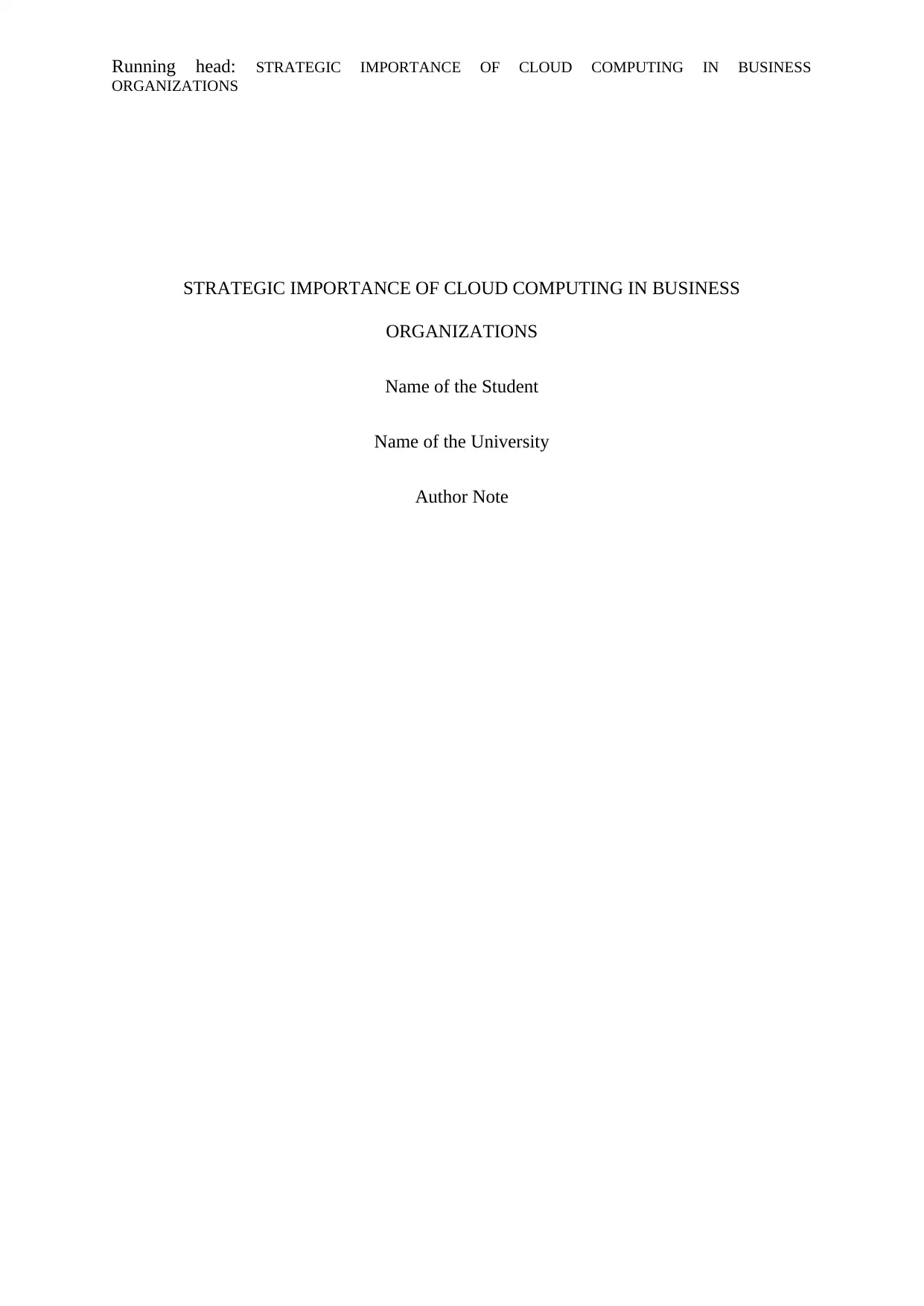
Running head: STRATEGIC IMPORTANCE OF CLOUD COMPUTING IN BUSINESS
ORGANIZATIONS
STRATEGIC IMPORTANCE OF CLOUD COMPUTING IN BUSINESS
ORGANIZATIONS
Name of the Student
Name of the University
Author Note
ORGANIZATIONS
STRATEGIC IMPORTANCE OF CLOUD COMPUTING IN BUSINESS
ORGANIZATIONS
Name of the Student
Name of the University
Author Note
Paraphrase This Document
Need a fresh take? Get an instant paraphrase of this document with our AI Paraphraser
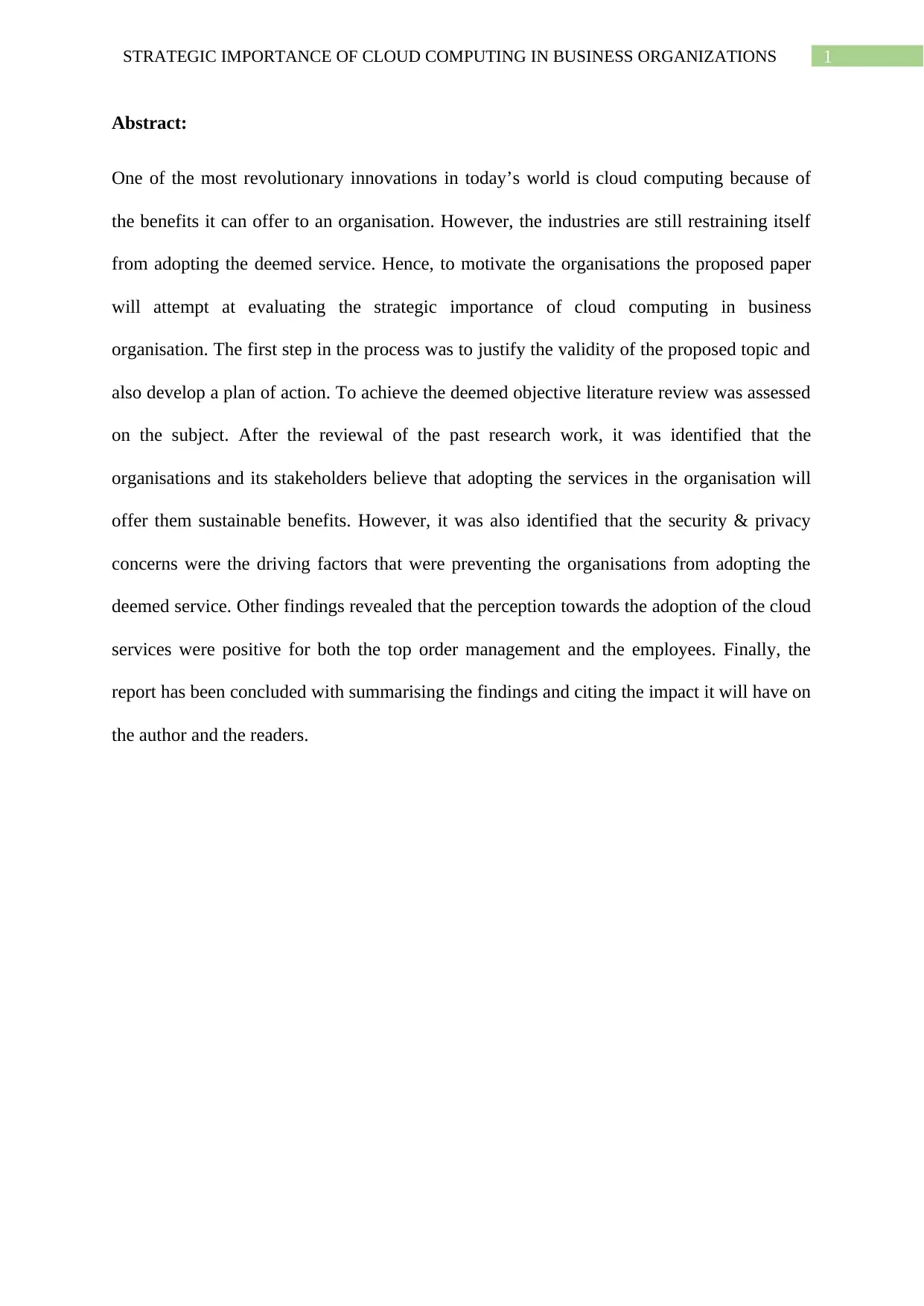
1STRATEGIC IMPORTANCE OF CLOUD COMPUTING IN BUSINESS ORGANIZATIONS
Abstract:
One of the most revolutionary innovations in today’s world is cloud computing because of
the benefits it can offer to an organisation. However, the industries are still restraining itself
from adopting the deemed service. Hence, to motivate the organisations the proposed paper
will attempt at evaluating the strategic importance of cloud computing in business
organisation. The first step in the process was to justify the validity of the proposed topic and
also develop a plan of action. To achieve the deemed objective literature review was assessed
on the subject. After the reviewal of the past research work, it was identified that the
organisations and its stakeholders believe that adopting the services in the organisation will
offer them sustainable benefits. However, it was also identified that the security & privacy
concerns were the driving factors that were preventing the organisations from adopting the
deemed service. Other findings revealed that the perception towards the adoption of the cloud
services were positive for both the top order management and the employees. Finally, the
report has been concluded with summarising the findings and citing the impact it will have on
the author and the readers.
Abstract:
One of the most revolutionary innovations in today’s world is cloud computing because of
the benefits it can offer to an organisation. However, the industries are still restraining itself
from adopting the deemed service. Hence, to motivate the organisations the proposed paper
will attempt at evaluating the strategic importance of cloud computing in business
organisation. The first step in the process was to justify the validity of the proposed topic and
also develop a plan of action. To achieve the deemed objective literature review was assessed
on the subject. After the reviewal of the past research work, it was identified that the
organisations and its stakeholders believe that adopting the services in the organisation will
offer them sustainable benefits. However, it was also identified that the security & privacy
concerns were the driving factors that were preventing the organisations from adopting the
deemed service. Other findings revealed that the perception towards the adoption of the cloud
services were positive for both the top order management and the employees. Finally, the
report has been concluded with summarising the findings and citing the impact it will have on
the author and the readers.
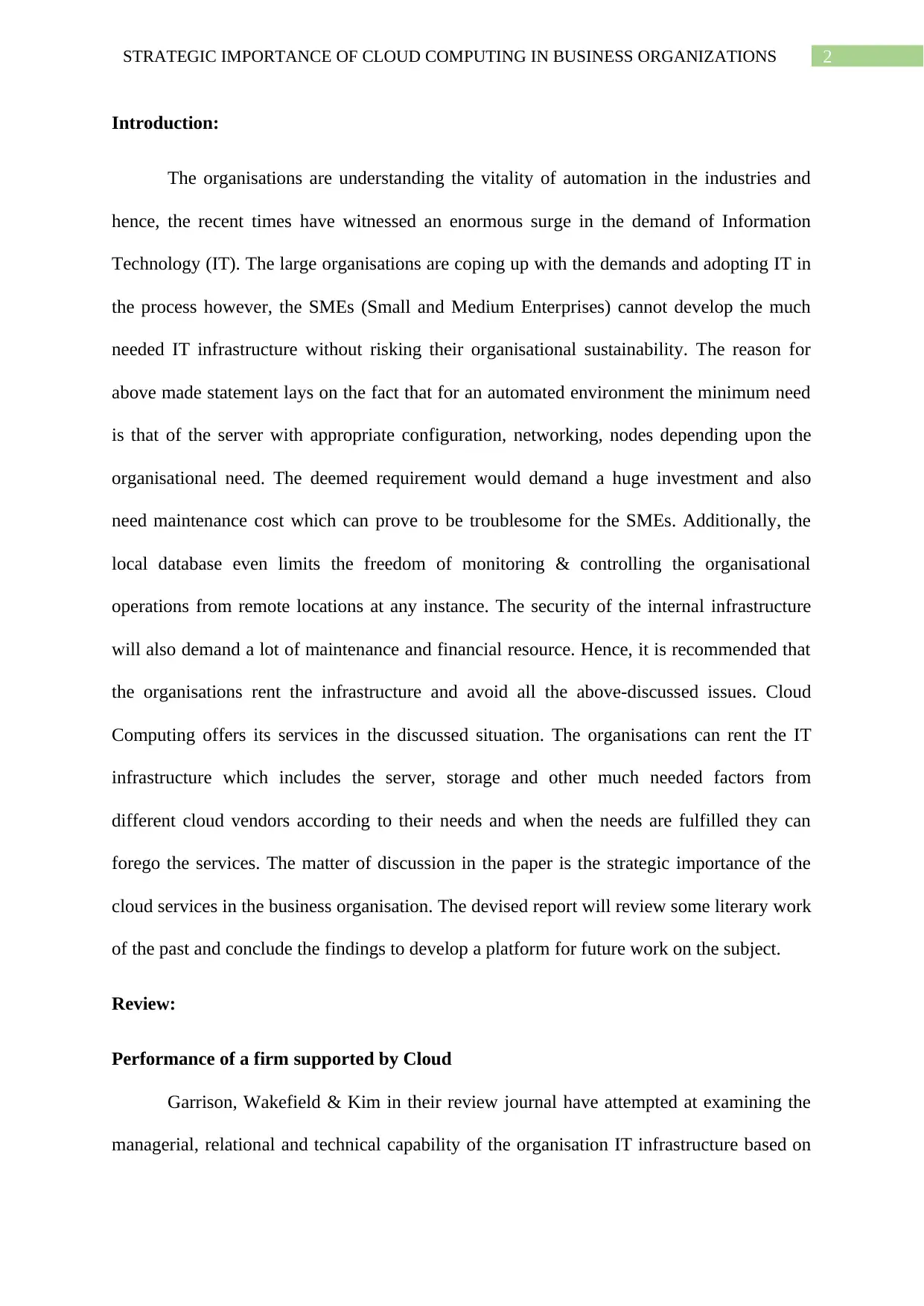
2STRATEGIC IMPORTANCE OF CLOUD COMPUTING IN BUSINESS ORGANIZATIONS
Introduction:
The organisations are understanding the vitality of automation in the industries and
hence, the recent times have witnessed an enormous surge in the demand of Information
Technology (IT). The large organisations are coping up with the demands and adopting IT in
the process however, the SMEs (Small and Medium Enterprises) cannot develop the much
needed IT infrastructure without risking their organisational sustainability. The reason for
above made statement lays on the fact that for an automated environment the minimum need
is that of the server with appropriate configuration, networking, nodes depending upon the
organisational need. The deemed requirement would demand a huge investment and also
need maintenance cost which can prove to be troublesome for the SMEs. Additionally, the
local database even limits the freedom of monitoring & controlling the organisational
operations from remote locations at any instance. The security of the internal infrastructure
will also demand a lot of maintenance and financial resource. Hence, it is recommended that
the organisations rent the infrastructure and avoid all the above-discussed issues. Cloud
Computing offers its services in the discussed situation. The organisations can rent the IT
infrastructure which includes the server, storage and other much needed factors from
different cloud vendors according to their needs and when the needs are fulfilled they can
forego the services. The matter of discussion in the paper is the strategic importance of the
cloud services in the business organisation. The devised report will review some literary work
of the past and conclude the findings to develop a platform for future work on the subject.
Review:
Performance of a firm supported by Cloud
Garrison, Wakefield & Kim in their review journal have attempted at examining the
managerial, relational and technical capability of the organisation IT infrastructure based on
Introduction:
The organisations are understanding the vitality of automation in the industries and
hence, the recent times have witnessed an enormous surge in the demand of Information
Technology (IT). The large organisations are coping up with the demands and adopting IT in
the process however, the SMEs (Small and Medium Enterprises) cannot develop the much
needed IT infrastructure without risking their organisational sustainability. The reason for
above made statement lays on the fact that for an automated environment the minimum need
is that of the server with appropriate configuration, networking, nodes depending upon the
organisational need. The deemed requirement would demand a huge investment and also
need maintenance cost which can prove to be troublesome for the SMEs. Additionally, the
local database even limits the freedom of monitoring & controlling the organisational
operations from remote locations at any instance. The security of the internal infrastructure
will also demand a lot of maintenance and financial resource. Hence, it is recommended that
the organisations rent the infrastructure and avoid all the above-discussed issues. Cloud
Computing offers its services in the discussed situation. The organisations can rent the IT
infrastructure which includes the server, storage and other much needed factors from
different cloud vendors according to their needs and when the needs are fulfilled they can
forego the services. The matter of discussion in the paper is the strategic importance of the
cloud services in the business organisation. The devised report will review some literary work
of the past and conclude the findings to develop a platform for future work on the subject.
Review:
Performance of a firm supported by Cloud
Garrison, Wakefield & Kim in their review journal have attempted at examining the
managerial, relational and technical capability of the organisation IT infrastructure based on
⊘ This is a preview!⊘
Do you want full access?
Subscribe today to unlock all pages.

Trusted by 1+ million students worldwide
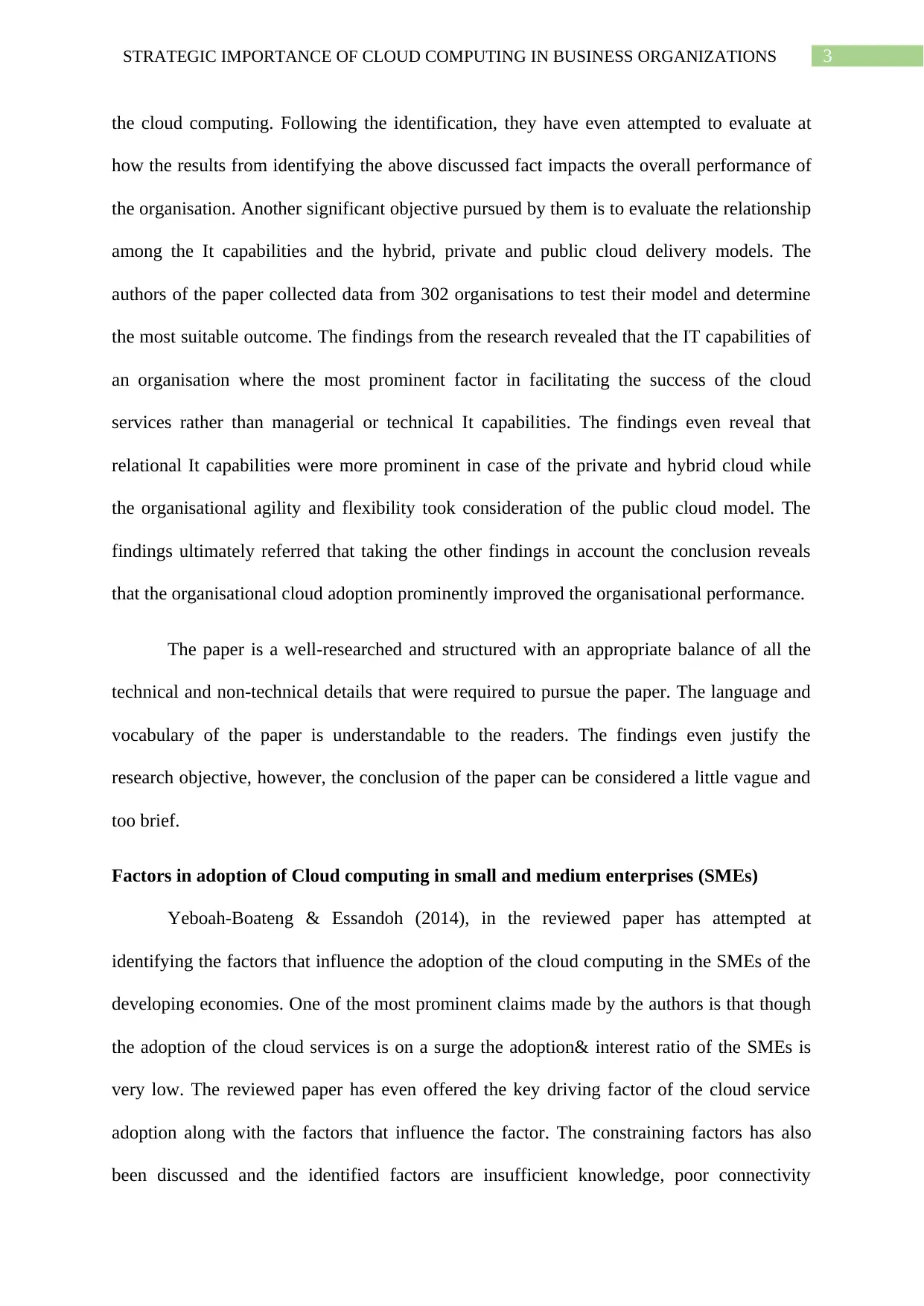
3STRATEGIC IMPORTANCE OF CLOUD COMPUTING IN BUSINESS ORGANIZATIONS
the cloud computing. Following the identification, they have even attempted to evaluate at
how the results from identifying the above discussed fact impacts the overall performance of
the organisation. Another significant objective pursued by them is to evaluate the relationship
among the It capabilities and the hybrid, private and public cloud delivery models. The
authors of the paper collected data from 302 organisations to test their model and determine
the most suitable outcome. The findings from the research revealed that the IT capabilities of
an organisation where the most prominent factor in facilitating the success of the cloud
services rather than managerial or technical It capabilities. The findings even reveal that
relational It capabilities were more prominent in case of the private and hybrid cloud while
the organisational agility and flexibility took consideration of the public cloud model. The
findings ultimately referred that taking the other findings in account the conclusion reveals
that the organisational cloud adoption prominently improved the organisational performance.
The paper is a well-researched and structured with an appropriate balance of all the
technical and non-technical details that were required to pursue the paper. The language and
vocabulary of the paper is understandable to the readers. The findings even justify the
research objective, however, the conclusion of the paper can be considered a little vague and
too brief.
Factors in adoption of Cloud computing in small and medium enterprises (SMEs)
Yeboah-Boateng & Essandoh (2014), in the reviewed paper has attempted at
identifying the factors that influence the adoption of the cloud computing in the SMEs of the
developing economies. One of the most prominent claims made by the authors is that though
the adoption of the cloud services is on a surge the adoption& interest ratio of the SMEs is
very low. The reviewed paper has even offered the key driving factor of the cloud service
adoption along with the factors that influence the factor. The constraining factors has also
been discussed and the identified factors are insufficient knowledge, poor connectivity
the cloud computing. Following the identification, they have even attempted to evaluate at
how the results from identifying the above discussed fact impacts the overall performance of
the organisation. Another significant objective pursued by them is to evaluate the relationship
among the It capabilities and the hybrid, private and public cloud delivery models. The
authors of the paper collected data from 302 organisations to test their model and determine
the most suitable outcome. The findings from the research revealed that the IT capabilities of
an organisation where the most prominent factor in facilitating the success of the cloud
services rather than managerial or technical It capabilities. The findings even reveal that
relational It capabilities were more prominent in case of the private and hybrid cloud while
the organisational agility and flexibility took consideration of the public cloud model. The
findings ultimately referred that taking the other findings in account the conclusion reveals
that the organisational cloud adoption prominently improved the organisational performance.
The paper is a well-researched and structured with an appropriate balance of all the
technical and non-technical details that were required to pursue the paper. The language and
vocabulary of the paper is understandable to the readers. The findings even justify the
research objective, however, the conclusion of the paper can be considered a little vague and
too brief.
Factors in adoption of Cloud computing in small and medium enterprises (SMEs)
Yeboah-Boateng & Essandoh (2014), in the reviewed paper has attempted at
identifying the factors that influence the adoption of the cloud computing in the SMEs of the
developing economies. One of the most prominent claims made by the authors is that though
the adoption of the cloud services is on a surge the adoption& interest ratio of the SMEs is
very low. The reviewed paper has even offered the key driving factor of the cloud service
adoption along with the factors that influence the factor. The constraining factors has also
been discussed and the identified factors are insufficient knowledge, poor connectivity
Paraphrase This Document
Need a fresh take? Get an instant paraphrase of this document with our AI Paraphraser
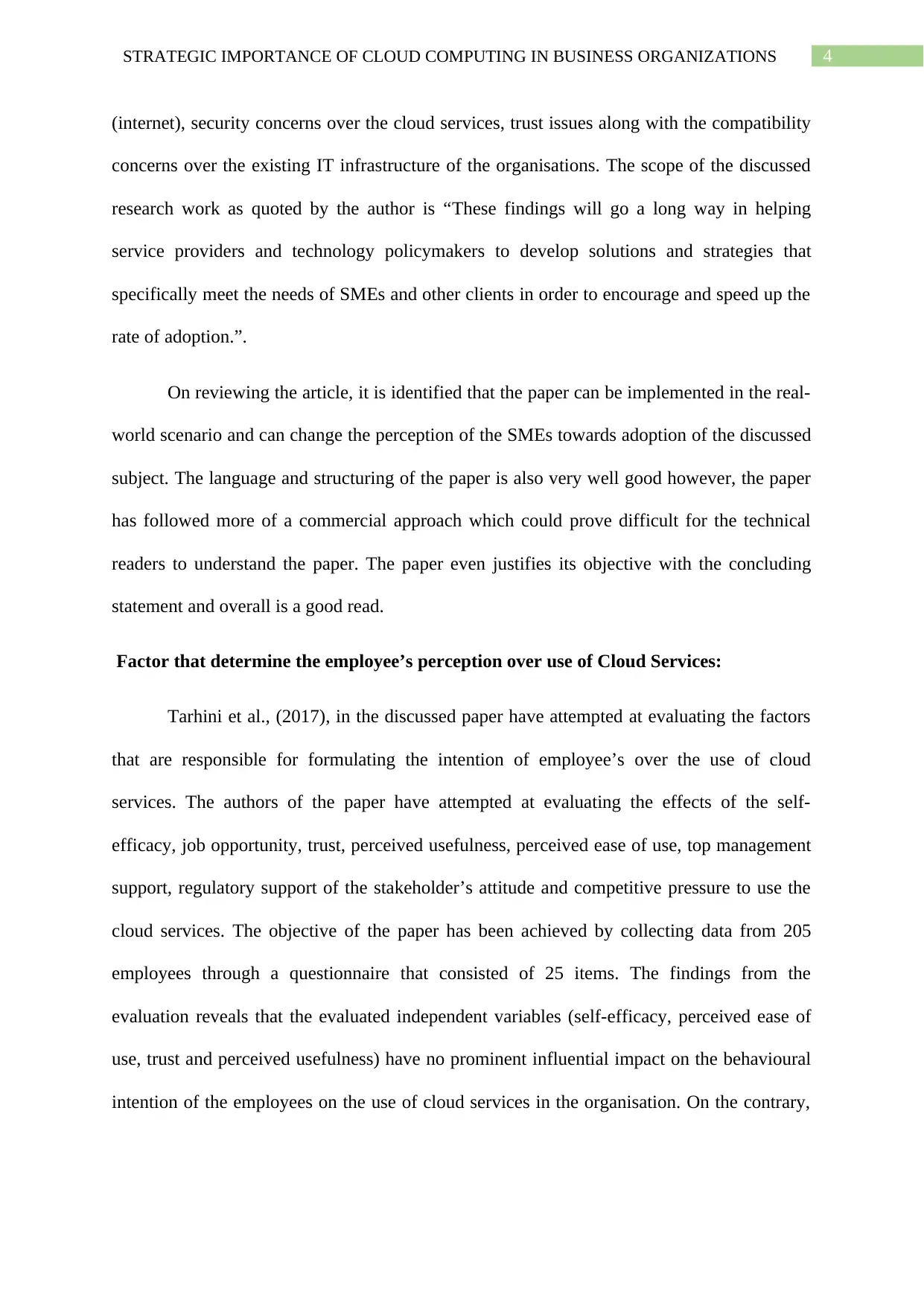
4STRATEGIC IMPORTANCE OF CLOUD COMPUTING IN BUSINESS ORGANIZATIONS
(internet), security concerns over the cloud services, trust issues along with the compatibility
concerns over the existing IT infrastructure of the organisations. The scope of the discussed
research work as quoted by the author is “These findings will go a long way in helping
service providers and technology policymakers to develop solutions and strategies that
specifically meet the needs of SMEs and other clients in order to encourage and speed up the
rate of adoption.”.
On reviewing the article, it is identified that the paper can be implemented in the real-
world scenario and can change the perception of the SMEs towards adoption of the discussed
subject. The language and structuring of the paper is also very well good however, the paper
has followed more of a commercial approach which could prove difficult for the technical
readers to understand the paper. The paper even justifies its objective with the concluding
statement and overall is a good read.
Factor that determine the employee’s perception over use of Cloud Services:
Tarhini et al., (2017), in the discussed paper have attempted at evaluating the factors
that are responsible for formulating the intention of employee’s over the use of cloud
services. The authors of the paper have attempted at evaluating the effects of the self-
efficacy, job opportunity, trust, perceived usefulness, perceived ease of use, top management
support, regulatory support of the stakeholder’s attitude and competitive pressure to use the
cloud services. The objective of the paper has been achieved by collecting data from 205
employees through a questionnaire that consisted of 25 items. The findings from the
evaluation reveals that the evaluated independent variables (self-efficacy, perceived ease of
use, trust and perceived usefulness) have no prominent influential impact on the behavioural
intention of the employees on the use of cloud services in the organisation. On the contrary,
(internet), security concerns over the cloud services, trust issues along with the compatibility
concerns over the existing IT infrastructure of the organisations. The scope of the discussed
research work as quoted by the author is “These findings will go a long way in helping
service providers and technology policymakers to develop solutions and strategies that
specifically meet the needs of SMEs and other clients in order to encourage and speed up the
rate of adoption.”.
On reviewing the article, it is identified that the paper can be implemented in the real-
world scenario and can change the perception of the SMEs towards adoption of the discussed
subject. The language and structuring of the paper is also very well good however, the paper
has followed more of a commercial approach which could prove difficult for the technical
readers to understand the paper. The paper even justifies its objective with the concluding
statement and overall is a good read.
Factor that determine the employee’s perception over use of Cloud Services:
Tarhini et al., (2017), in the discussed paper have attempted at evaluating the factors
that are responsible for formulating the intention of employee’s over the use of cloud
services. The authors of the paper have attempted at evaluating the effects of the self-
efficacy, job opportunity, trust, perceived usefulness, perceived ease of use, top management
support, regulatory support of the stakeholder’s attitude and competitive pressure to use the
cloud services. The objective of the paper has been achieved by collecting data from 205
employees through a questionnaire that consisted of 25 items. The findings from the
evaluation reveals that the evaluated independent variables (self-efficacy, perceived ease of
use, trust and perceived usefulness) have no prominent influential impact on the behavioural
intention of the employees on the use of cloud services in the organisation. On the contrary,
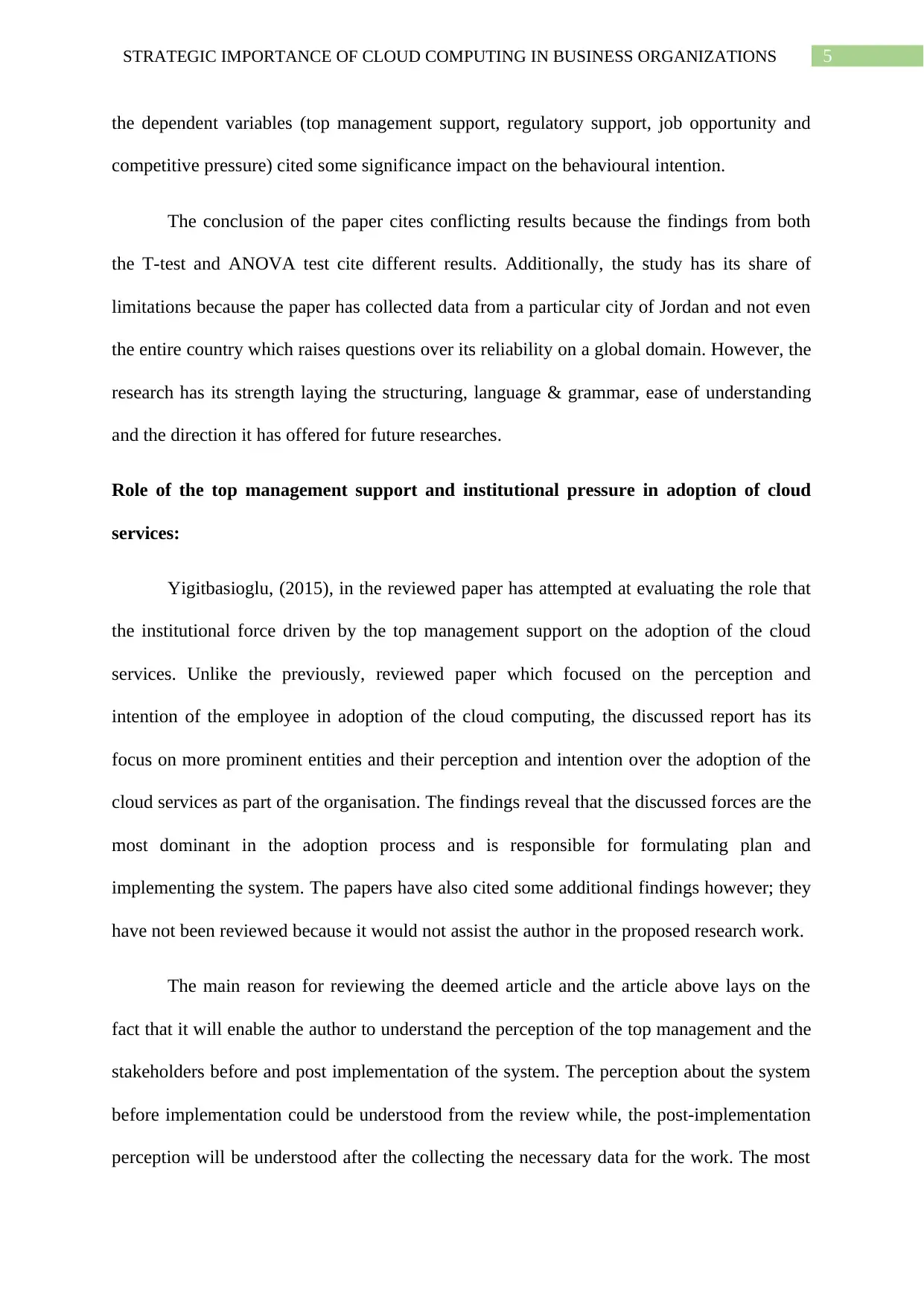
5STRATEGIC IMPORTANCE OF CLOUD COMPUTING IN BUSINESS ORGANIZATIONS
the dependent variables (top management support, regulatory support, job opportunity and
competitive pressure) cited some significance impact on the behavioural intention.
The conclusion of the paper cites conflicting results because the findings from both
the T-test and ANOVA test cite different results. Additionally, the study has its share of
limitations because the paper has collected data from a particular city of Jordan and not even
the entire country which raises questions over its reliability on a global domain. However, the
research has its strength laying the structuring, language & grammar, ease of understanding
and the direction it has offered for future researches.
Role of the top management support and institutional pressure in adoption of cloud
services:
Yigitbasioglu, (2015), in the reviewed paper has attempted at evaluating the role that
the institutional force driven by the top management support on the adoption of the cloud
services. Unlike the previously, reviewed paper which focused on the perception and
intention of the employee in adoption of the cloud computing, the discussed report has its
focus on more prominent entities and their perception and intention over the adoption of the
cloud services as part of the organisation. The findings reveal that the discussed forces are the
most dominant in the adoption process and is responsible for formulating plan and
implementing the system. The papers have also cited some additional findings however; they
have not been reviewed because it would not assist the author in the proposed research work.
The main reason for reviewing the deemed article and the article above lays on the
fact that it will enable the author to understand the perception of the top management and the
stakeholders before and post implementation of the system. The perception about the system
before implementation could be understood from the review while, the post-implementation
perception will be understood after the collecting the necessary data for the work. The most
the dependent variables (top management support, regulatory support, job opportunity and
competitive pressure) cited some significance impact on the behavioural intention.
The conclusion of the paper cites conflicting results because the findings from both
the T-test and ANOVA test cite different results. Additionally, the study has its share of
limitations because the paper has collected data from a particular city of Jordan and not even
the entire country which raises questions over its reliability on a global domain. However, the
research has its strength laying the structuring, language & grammar, ease of understanding
and the direction it has offered for future researches.
Role of the top management support and institutional pressure in adoption of cloud
services:
Yigitbasioglu, (2015), in the reviewed paper has attempted at evaluating the role that
the institutional force driven by the top management support on the adoption of the cloud
services. Unlike the previously, reviewed paper which focused on the perception and
intention of the employee in adoption of the cloud computing, the discussed report has its
focus on more prominent entities and their perception and intention over the adoption of the
cloud services as part of the organisation. The findings reveal that the discussed forces are the
most dominant in the adoption process and is responsible for formulating plan and
implementing the system. The papers have also cited some additional findings however; they
have not been reviewed because it would not assist the author in the proposed research work.
The main reason for reviewing the deemed article and the article above lays on the
fact that it will enable the author to understand the perception of the top management and the
stakeholders before and post implementation of the system. The perception about the system
before implementation could be understood from the review while, the post-implementation
perception will be understood after the collecting the necessary data for the work. The most
⊘ This is a preview!⊘
Do you want full access?
Subscribe today to unlock all pages.

Trusted by 1+ million students worldwide
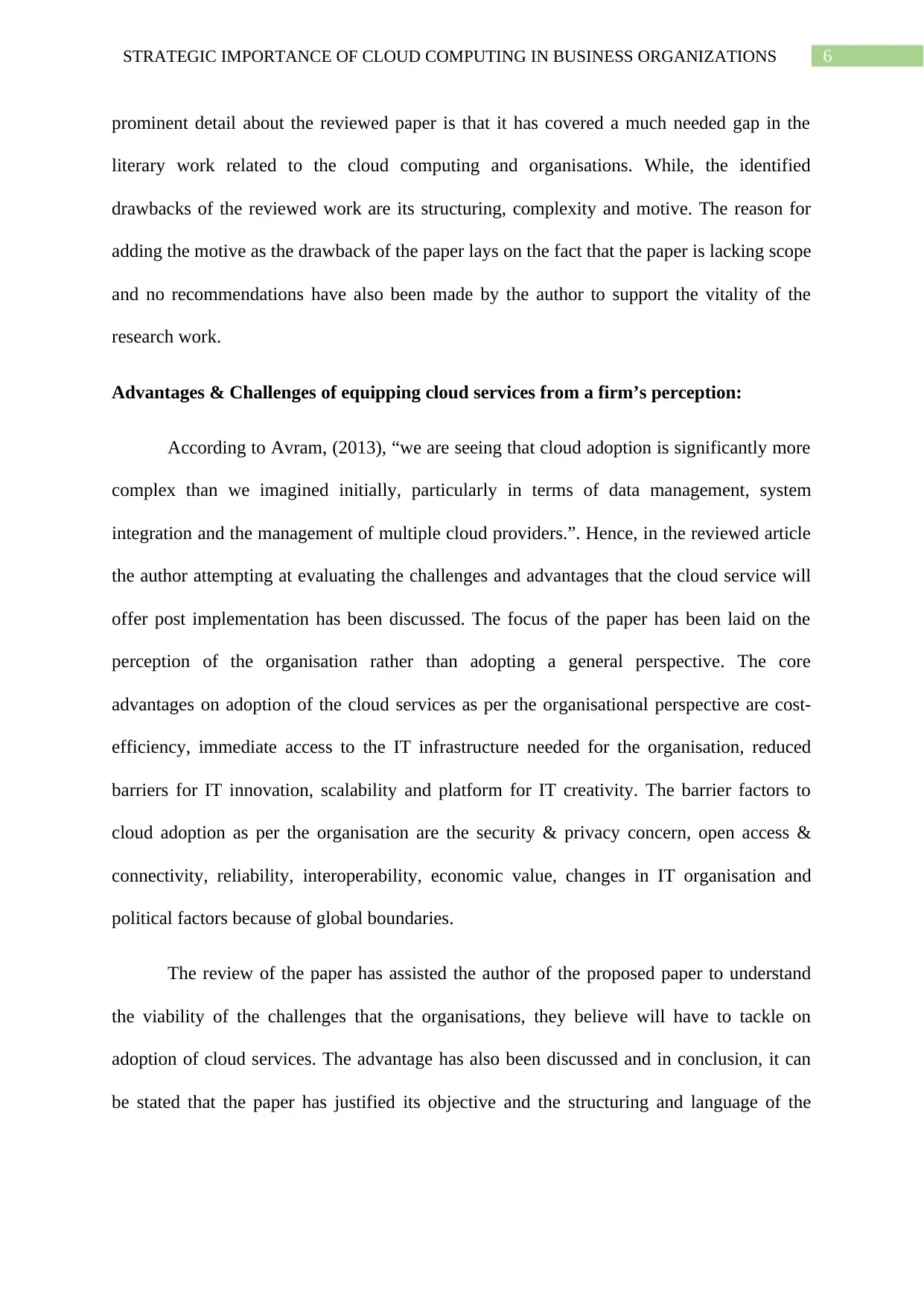
6STRATEGIC IMPORTANCE OF CLOUD COMPUTING IN BUSINESS ORGANIZATIONS
prominent detail about the reviewed paper is that it has covered a much needed gap in the
literary work related to the cloud computing and organisations. While, the identified
drawbacks of the reviewed work are its structuring, complexity and motive. The reason for
adding the motive as the drawback of the paper lays on the fact that the paper is lacking scope
and no recommendations have also been made by the author to support the vitality of the
research work.
Advantages & Challenges of equipping cloud services from a firm’s perception:
According to Avram, (2013), “we are seeing that cloud adoption is significantly more
complex than we imagined initially, particularly in terms of data management, system
integration and the management of multiple cloud providers.”. Hence, in the reviewed article
the author attempting at evaluating the challenges and advantages that the cloud service will
offer post implementation has been discussed. The focus of the paper has been laid on the
perception of the organisation rather than adopting a general perspective. The core
advantages on adoption of the cloud services as per the organisational perspective are cost-
efficiency, immediate access to the IT infrastructure needed for the organisation, reduced
barriers for IT innovation, scalability and platform for IT creativity. The barrier factors to
cloud adoption as per the organisation are the security & privacy concern, open access &
connectivity, reliability, interoperability, economic value, changes in IT organisation and
political factors because of global boundaries.
The review of the paper has assisted the author of the proposed paper to understand
the viability of the challenges that the organisations, they believe will have to tackle on
adoption of cloud services. The advantage has also been discussed and in conclusion, it can
be stated that the paper has justified its objective and the structuring and language of the
prominent detail about the reviewed paper is that it has covered a much needed gap in the
literary work related to the cloud computing and organisations. While, the identified
drawbacks of the reviewed work are its structuring, complexity and motive. The reason for
adding the motive as the drawback of the paper lays on the fact that the paper is lacking scope
and no recommendations have also been made by the author to support the vitality of the
research work.
Advantages & Challenges of equipping cloud services from a firm’s perception:
According to Avram, (2013), “we are seeing that cloud adoption is significantly more
complex than we imagined initially, particularly in terms of data management, system
integration and the management of multiple cloud providers.”. Hence, in the reviewed article
the author attempting at evaluating the challenges and advantages that the cloud service will
offer post implementation has been discussed. The focus of the paper has been laid on the
perception of the organisation rather than adopting a general perspective. The core
advantages on adoption of the cloud services as per the organisational perspective are cost-
efficiency, immediate access to the IT infrastructure needed for the organisation, reduced
barriers for IT innovation, scalability and platform for IT creativity. The barrier factors to
cloud adoption as per the organisation are the security & privacy concern, open access &
connectivity, reliability, interoperability, economic value, changes in IT organisation and
political factors because of global boundaries.
The review of the paper has assisted the author of the proposed paper to understand
the viability of the challenges that the organisations, they believe will have to tackle on
adoption of cloud services. The advantage has also been discussed and in conclusion, it can
be stated that the paper has justified its objective and the structuring and language of the
Paraphrase This Document
Need a fresh take? Get an instant paraphrase of this document with our AI Paraphraser
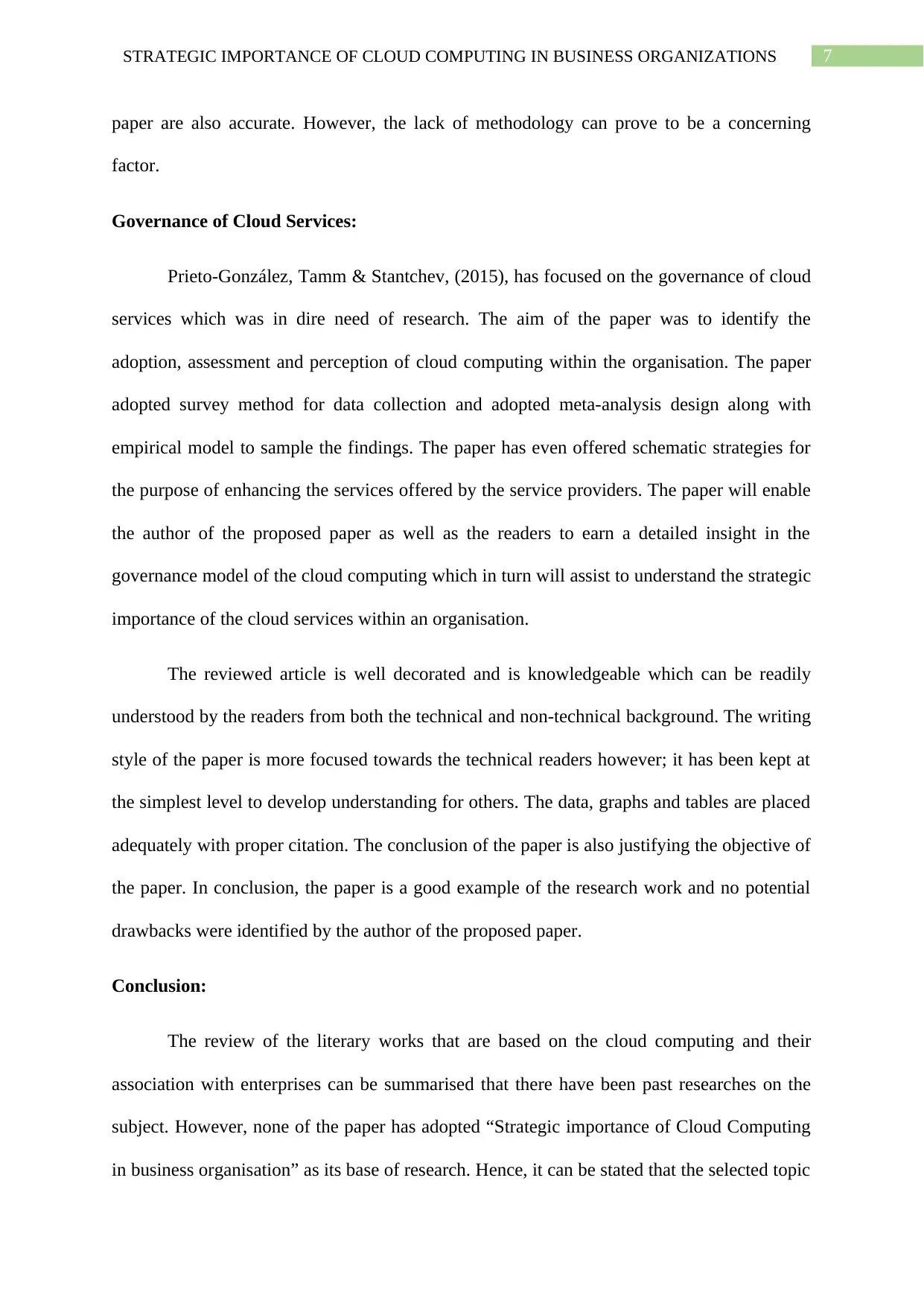
7STRATEGIC IMPORTANCE OF CLOUD COMPUTING IN BUSINESS ORGANIZATIONS
paper are also accurate. However, the lack of methodology can prove to be a concerning
factor.
Governance of Cloud Services:
Prieto-González, Tamm & Stantchev, (2015), has focused on the governance of cloud
services which was in dire need of research. The aim of the paper was to identify the
adoption, assessment and perception of cloud computing within the organisation. The paper
adopted survey method for data collection and adopted meta-analysis design along with
empirical model to sample the findings. The paper has even offered schematic strategies for
the purpose of enhancing the services offered by the service providers. The paper will enable
the author of the proposed paper as well as the readers to earn a detailed insight in the
governance model of the cloud computing which in turn will assist to understand the strategic
importance of the cloud services within an organisation.
The reviewed article is well decorated and is knowledgeable which can be readily
understood by the readers from both the technical and non-technical background. The writing
style of the paper is more focused towards the technical readers however; it has been kept at
the simplest level to develop understanding for others. The data, graphs and tables are placed
adequately with proper citation. The conclusion of the paper is also justifying the objective of
the paper. In conclusion, the paper is a good example of the research work and no potential
drawbacks were identified by the author of the proposed paper.
Conclusion:
The review of the literary works that are based on the cloud computing and their
association with enterprises can be summarised that there have been past researches on the
subject. However, none of the paper has adopted “Strategic importance of Cloud Computing
in business organisation” as its base of research. Hence, it can be stated that the selected topic
paper are also accurate. However, the lack of methodology can prove to be a concerning
factor.
Governance of Cloud Services:
Prieto-González, Tamm & Stantchev, (2015), has focused on the governance of cloud
services which was in dire need of research. The aim of the paper was to identify the
adoption, assessment and perception of cloud computing within the organisation. The paper
adopted survey method for data collection and adopted meta-analysis design along with
empirical model to sample the findings. The paper has even offered schematic strategies for
the purpose of enhancing the services offered by the service providers. The paper will enable
the author of the proposed paper as well as the readers to earn a detailed insight in the
governance model of the cloud computing which in turn will assist to understand the strategic
importance of the cloud services within an organisation.
The reviewed article is well decorated and is knowledgeable which can be readily
understood by the readers from both the technical and non-technical background. The writing
style of the paper is more focused towards the technical readers however; it has been kept at
the simplest level to develop understanding for others. The data, graphs and tables are placed
adequately with proper citation. The conclusion of the paper is also justifying the objective of
the paper. In conclusion, the paper is a good example of the research work and no potential
drawbacks were identified by the author of the proposed paper.
Conclusion:
The review of the literary works that are based on the cloud computing and their
association with enterprises can be summarised that there have been past researches on the
subject. However, none of the paper has adopted “Strategic importance of Cloud Computing
in business organisation” as its base of research. Hence, it can be stated that the selected topic
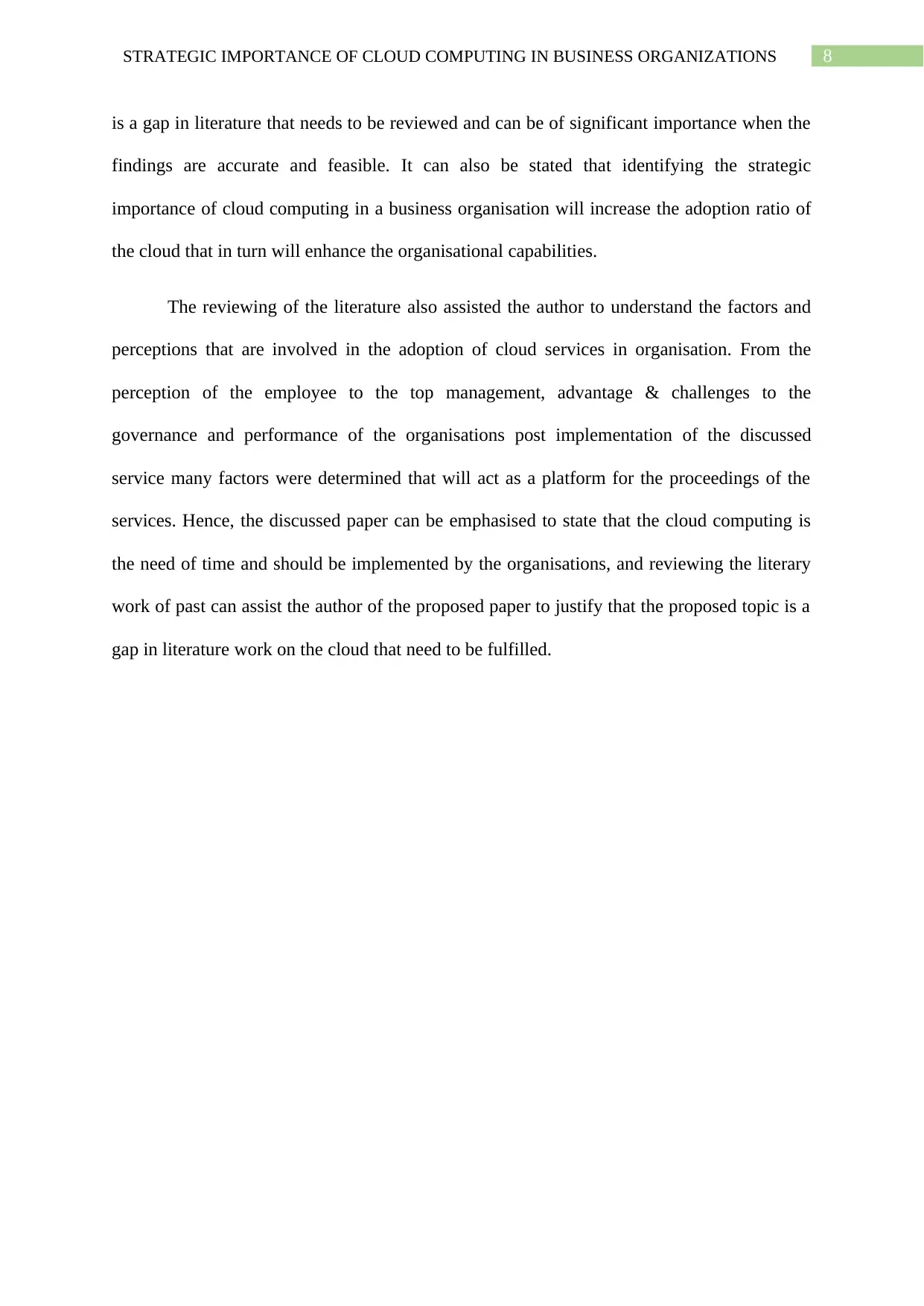
8STRATEGIC IMPORTANCE OF CLOUD COMPUTING IN BUSINESS ORGANIZATIONS
is a gap in literature that needs to be reviewed and can be of significant importance when the
findings are accurate and feasible. It can also be stated that identifying the strategic
importance of cloud computing in a business organisation will increase the adoption ratio of
the cloud that in turn will enhance the organisational capabilities.
The reviewing of the literature also assisted the author to understand the factors and
perceptions that are involved in the adoption of cloud services in organisation. From the
perception of the employee to the top management, advantage & challenges to the
governance and performance of the organisations post implementation of the discussed
service many factors were determined that will act as a platform for the proceedings of the
services. Hence, the discussed paper can be emphasised to state that the cloud computing is
the need of time and should be implemented by the organisations, and reviewing the literary
work of past can assist the author of the proposed paper to justify that the proposed topic is a
gap in literature work on the cloud that need to be fulfilled.
is a gap in literature that needs to be reviewed and can be of significant importance when the
findings are accurate and feasible. It can also be stated that identifying the strategic
importance of cloud computing in a business organisation will increase the adoption ratio of
the cloud that in turn will enhance the organisational capabilities.
The reviewing of the literature also assisted the author to understand the factors and
perceptions that are involved in the adoption of cloud services in organisation. From the
perception of the employee to the top management, advantage & challenges to the
governance and performance of the organisations post implementation of the discussed
service many factors were determined that will act as a platform for the proceedings of the
services. Hence, the discussed paper can be emphasised to state that the cloud computing is
the need of time and should be implemented by the organisations, and reviewing the literary
work of past can assist the author of the proposed paper to justify that the proposed topic is a
gap in literature work on the cloud that need to be fulfilled.
⊘ This is a preview!⊘
Do you want full access?
Subscribe today to unlock all pages.

Trusted by 1+ million students worldwide
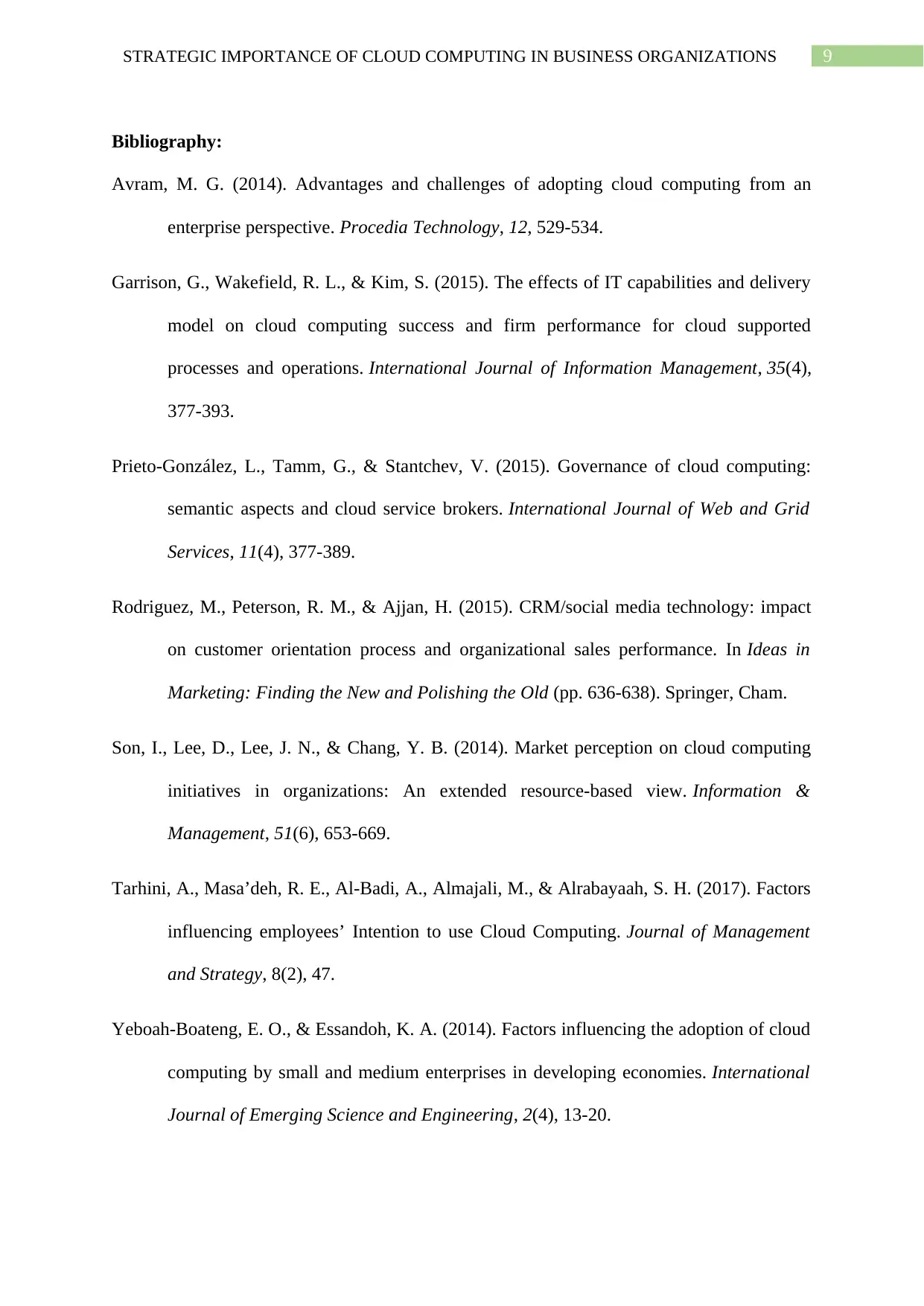
9STRATEGIC IMPORTANCE OF CLOUD COMPUTING IN BUSINESS ORGANIZATIONS
Bibliography:
Avram, M. G. (2014). Advantages and challenges of adopting cloud computing from an
enterprise perspective. Procedia Technology, 12, 529-534.
Garrison, G., Wakefield, R. L., & Kim, S. (2015). The effects of IT capabilities and delivery
model on cloud computing success and firm performance for cloud supported
processes and operations. International Journal of Information Management, 35(4),
377-393.
Prieto-González, L., Tamm, G., & Stantchev, V. (2015). Governance of cloud computing:
semantic aspects and cloud service brokers. International Journal of Web and Grid
Services, 11(4), 377-389.
Rodriguez, M., Peterson, R. M., & Ajjan, H. (2015). CRM/social media technology: impact
on customer orientation process and organizational sales performance. In Ideas in
Marketing: Finding the New and Polishing the Old (pp. 636-638). Springer, Cham.
Son, I., Lee, D., Lee, J. N., & Chang, Y. B. (2014). Market perception on cloud computing
initiatives in organizations: An extended resource-based view. Information &
Management, 51(6), 653-669.
Tarhini, A., Masa’deh, R. E., Al-Badi, A., Almajali, M., & Alrabayaah, S. H. (2017). Factors
influencing employees’ Intention to use Cloud Computing. Journal of Management
and Strategy, 8(2), 47.
Yeboah-Boateng, E. O., & Essandoh, K. A. (2014). Factors influencing the adoption of cloud
computing by small and medium enterprises in developing economies. International
Journal of Emerging Science and Engineering, 2(4), 13-20.
Bibliography:
Avram, M. G. (2014). Advantages and challenges of adopting cloud computing from an
enterprise perspective. Procedia Technology, 12, 529-534.
Garrison, G., Wakefield, R. L., & Kim, S. (2015). The effects of IT capabilities and delivery
model on cloud computing success and firm performance for cloud supported
processes and operations. International Journal of Information Management, 35(4),
377-393.
Prieto-González, L., Tamm, G., & Stantchev, V. (2015). Governance of cloud computing:
semantic aspects and cloud service brokers. International Journal of Web and Grid
Services, 11(4), 377-389.
Rodriguez, M., Peterson, R. M., & Ajjan, H. (2015). CRM/social media technology: impact
on customer orientation process and organizational sales performance. In Ideas in
Marketing: Finding the New and Polishing the Old (pp. 636-638). Springer, Cham.
Son, I., Lee, D., Lee, J. N., & Chang, Y. B. (2014). Market perception on cloud computing
initiatives in organizations: An extended resource-based view. Information &
Management, 51(6), 653-669.
Tarhini, A., Masa’deh, R. E., Al-Badi, A., Almajali, M., & Alrabayaah, S. H. (2017). Factors
influencing employees’ Intention to use Cloud Computing. Journal of Management
and Strategy, 8(2), 47.
Yeboah-Boateng, E. O., & Essandoh, K. A. (2014). Factors influencing the adoption of cloud
computing by small and medium enterprises in developing economies. International
Journal of Emerging Science and Engineering, 2(4), 13-20.
Paraphrase This Document
Need a fresh take? Get an instant paraphrase of this document with our AI Paraphraser
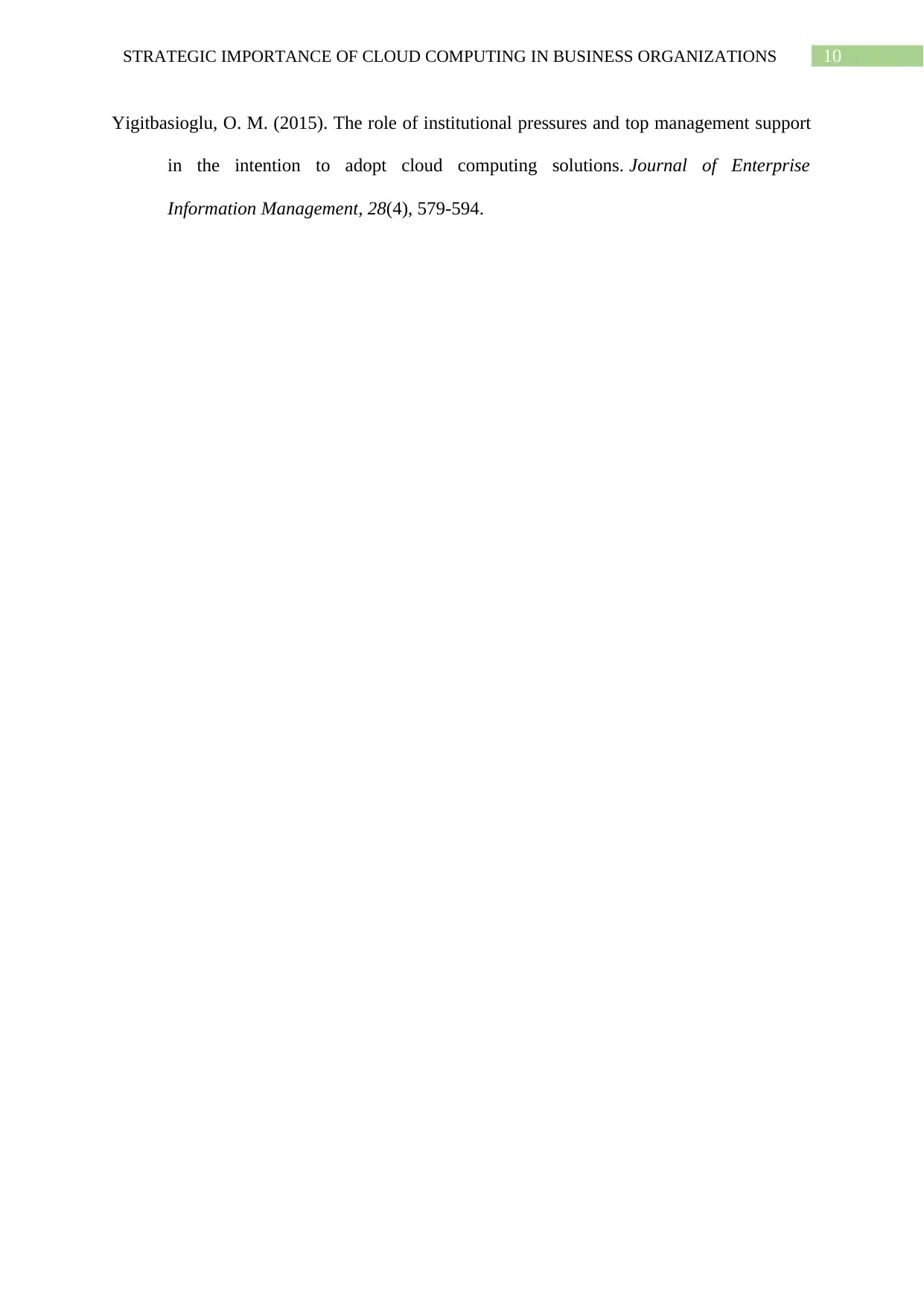
10STRATEGIC IMPORTANCE OF CLOUD COMPUTING IN BUSINESS ORGANIZATIONS
Yigitbasioglu, O. M. (2015). The role of institutional pressures and top management support
in the intention to adopt cloud computing solutions. Journal of Enterprise
Information Management, 28(4), 579-594.
Yigitbasioglu, O. M. (2015). The role of institutional pressures and top management support
in the intention to adopt cloud computing solutions. Journal of Enterprise
Information Management, 28(4), 579-594.
1 out of 11
Related Documents
Your All-in-One AI-Powered Toolkit for Academic Success.
+13062052269
info@desklib.com
Available 24*7 on WhatsApp / Email
![[object Object]](/_next/static/media/star-bottom.7253800d.svg)
Unlock your academic potential
Copyright © 2020–2025 A2Z Services. All Rights Reserved. Developed and managed by ZUCOL.



